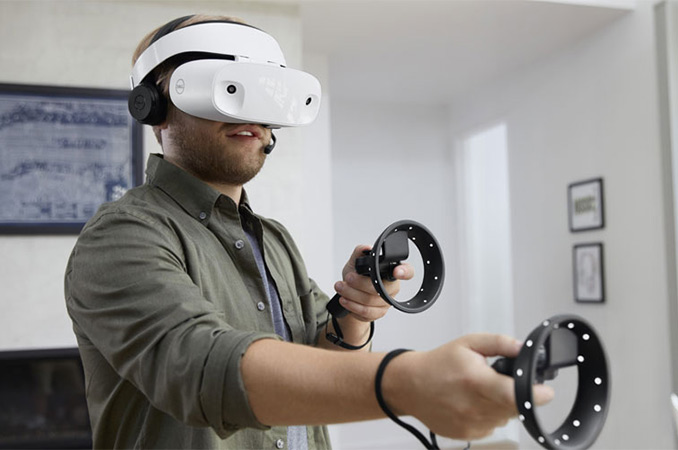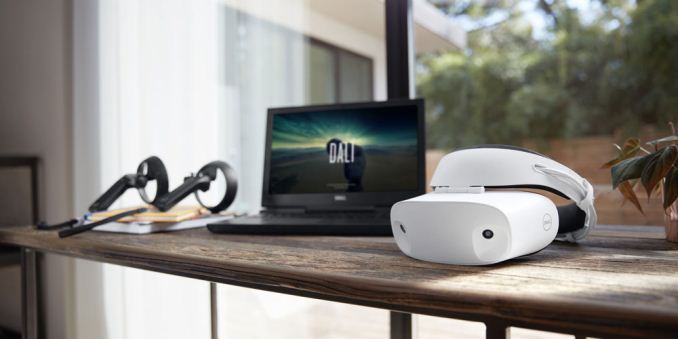Dell’s Visor Available for Pre-Order: A Mixed Reality Headset, Ships in Mid-October
by Anton Shilov on September 14, 2017 4:00 PM EST- Posted in
- VR
- Dell
- Microsoft
- Windows 10
- Visor
- Windows Mixed Reality

Dell has begun to take pre-orders on its Visor headset for Windows Mixed Reality applications. The company will start shipments of the device in mid-October, just in time for Microsoft’s Windows 10 Creators Update that arrives on October 17 and ahead of the holiday season.
Starting from September 14, Dell’s Visor WMR headset is available for pre-order from Dell.com/Visor in the U.S. and from PCWorld in the U.K. The headset itself is priced at $349.99, the controller kit costs $99.99 and a Visor with controllers is priced at $449.99. In the U.K., the whole kit is available for pre-order at £429.99. In order to play non-controller based AR/VR games on the Visor, users will also have to get an Xbox One controller. Dell will start to ship its Visor product on October 17, 2017. In addition, the company plans to make the device available in BestBuy stores and directly from Microsoft (online and offline).
Dell’s Visor AR/VR headset complies with Microsoft’s requirements for headsets compatible with the Windows Mixed Reality platform: it connects to Windows 10-based PCs using HDMI and USB cables, it features two 1440×1440@90 Hz LCD panels (for a total resolution of 2880×1440) and two cameras to capture the outside world. While ergonomics and industrial designs of WMR-compliant headsets from Dell, Acer, ASUS and Lenovo are different, internally they end up being very similar.
The shipments date of the Dell Visor coincides with the launch date of Microsoft’s Windows 10 Creators Update, which will bring support for Windows Mixed Reality headsets to end users. That said it is highly likely that other makers of WMR gear will try to ship their products around the time of the official launch of the platform. In the meantime, Dell seems to be the first with pre-orders.
Related Reading
Source: Dell











33 Comments
View All Comments
peevee - Thursday, September 14, 2017 - link
Insanely ugly stuff.kaidenshi - Thursday, September 14, 2017 - link
VR hardware hasn't changed since the mid 90s. Check out "The Plague's" setup in the movie "Hackers" from 1995.Crono - Thursday, September 14, 2017 - link
How much did a setup like that cost in the 90s?kaidenshi - Thursday, September 14, 2017 - link
I was still in high school in 1995, so I have no clue, but just guessing I'd say it was in the range of "if you have to ask you can't afford it". That was the point of his setup in the movie; he was making a killing off of the worm he infected tanker ships with, along with his legitimate paycheck for IT security. The VR setup was his version of a supercar or yacht.Also, even though 90s era VR hardware looked the same on the outside as modern units, the graphics were barely better than the Nintendo Virtual Boy.
Flunk - Friday, September 15, 2017 - link
And you wouldn't use 90's VR technology to hack anything. Come to think about it, don't use the movie hackers as a reference for anything, it's completely and laughably inaccurate. It's a fun movie, but you shouldn't think anything in it is representative of reality in any way.JoeyJoJo123 - Friday, September 15, 2017 - link
This.kaidenshi - Saturday, September 16, 2017 - link
He wasn't "hacking" anything, he was playing a game. I used that scene as an example because they used real off the shelf hardware available at the time to set up the scene. I'm well aware it was a movie and not reality, but it was a prop based off of a real VR setup.extide - Friday, September 15, 2017 - link
That wasn't a commercial product, just props in a movie..kaidenshi - Saturday, September 16, 2017 - link
Actually it was. I got bored and did a little research, and it appears to be made by a company called Virtuality Group. And at $65,000, I was right: It's "if you have to ask you can't afford it" kind of money, especially in the 90s.https://en.wikipedia.org/wiki/Virtuality_(gaming)
edzieba - Friday, September 15, 2017 - link
You couldn't buy a comparable setup in the 90s even with Government Money.The technology used today was just not available then. No MEMS IMUs, IMUs of comparable capability were large, heavy, and extremely expensive. No OLED panels, you had a choice of CRT (heavy, hot), LCD (low resolution, low refresh rate, extremely high persistence because you had TN or bust), or the very early engineering prototypes of AMEL (the inorganic predecesor to OLED). Lack of IMUs meant no sensor fusion, just pure optical tracking, with the systems at the time being /relatively/ capable (behind Constellation or Lighthouse in latency and fidelity though, but more robust due to the number of cameras) but extremely expensive. Inside-out tracking would just be a flat "no", SLAM at the time was nowhere close to suitable for VR.